Facades of Four Sorts
Topic: Historic Hollywood
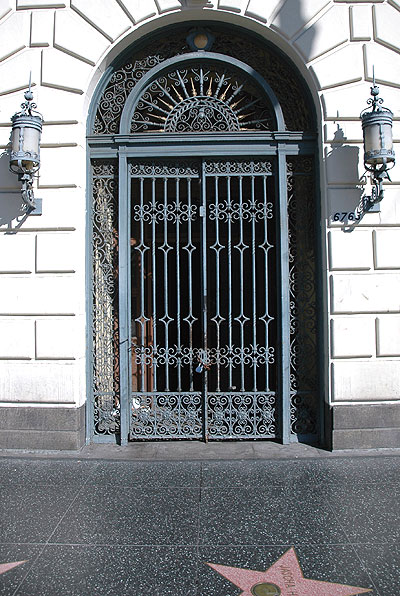 The mysterious door at 6763 Hollywood Boulevard, a well preserved, two-story Classic Revival building. In the twenties, the Montmartre Café, a popular nightclub, was up on the second floor, and next door was the Embassy Club, a fashionable private club that catered to Hollywood's elite back then. It's all locked up now. Those days are long gone. The star in the sidewalk there, in the Walk of Fame, reads Jascha Heifetz.
The mysterious door at 6763 Hollywood Boulevard, a well preserved, two-story Classic Revival building. In the twenties, the Montmartre Café, a popular nightclub, was up on the second floor, and next door was the Embassy Club, a fashionable private club that catered to Hollywood's elite back then. It's all locked up now. Those days are long gone. The star in the sidewalk there, in the Walk of Fame, reads Jascha Heifetz.
Jascha Heifetz (1901-1987) was, they say, the greatest violinist of the 20th Century. So he gets his star in the sidewalk in Hollywood.
Heifetz was born in Vilna in Lithuania, then a part of Russia. But he's really a local. Yeah, when he was twelve he met Fritz Kreisler for the first time in a Berlin private home with all the big gun violinists of the day, and the story goes that when Kreisler finished accompanying Heifetz at the piano (the Mendelssohn Concerto), Kreisler said to them all, "Now we can all break our fiddles across our knees." And there was the first time Heifetz played in the United States - October 27, 1917, Carnegie Hall. Violinist Mischa Elman in the audience complained - "Phew, it’s hot in here." Leopold Godowsky, in the next seat, smiled and said "not for pianists." Heifetz became an American citizen in 1925 and ended up out here. When he told Harpo Marx (a great admirer) that he had been earning his living as a musician since the age of seven, Harpo quipped, "and I suppose before that you were just a bum." Harpo Marx did speak, after all. Hollywood in its Golden Age must have been a strange place.
Heifetz taught the violin out here, first at UCLA then at the University of Southern California, with his buddy Gregor Piatigorsky. And as late as the 1980s he held classes in his private studio in his home in Beverly Hills. He died at the Cedar-Sinai Medical Center down the hill from here - after brain surgery as a result of a fall and loss of consciousness at the Beverly Hills place.
And he has his star in the sidewalk. __
Behind the building is the not very mysterious back door to the Stella Adler Theater and the Stella Adler Academy of Acting, the parking lot entrance. It's very brash. You can find a list of those who have studied with Stella Adler here - it's not just these two. (For a front view click here, a shot from mid-January.)
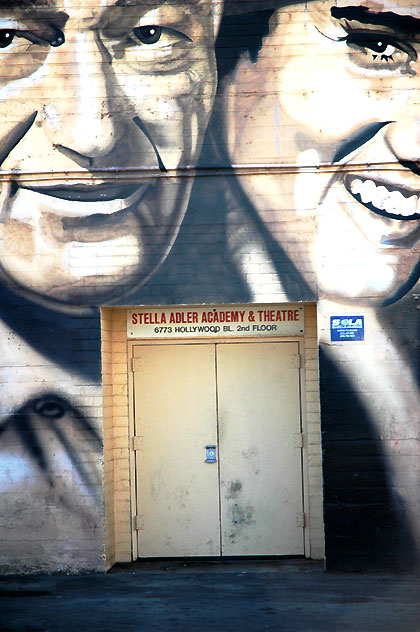
Some walls have no history, but they're cool - one block north of the others, the Yucca Street Community Center, Cherokee at Yucca.
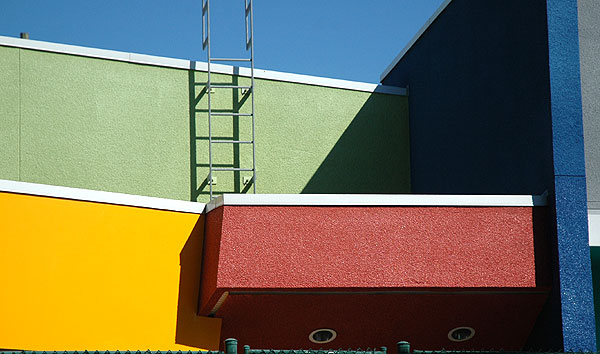
A blue wall, Cherokee at Hollywood Boulevard, providing irony…
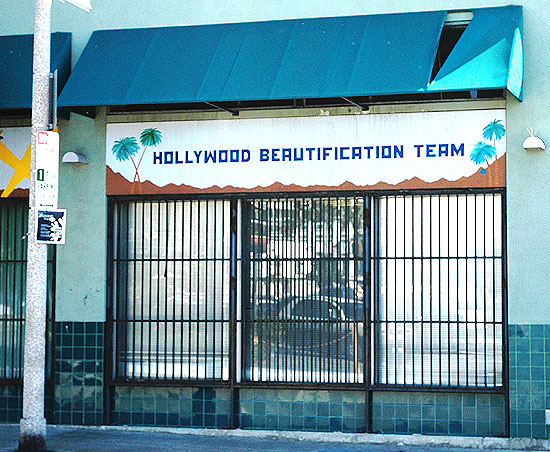
1927 Rococo Madness
Topic: Historic Hollywood
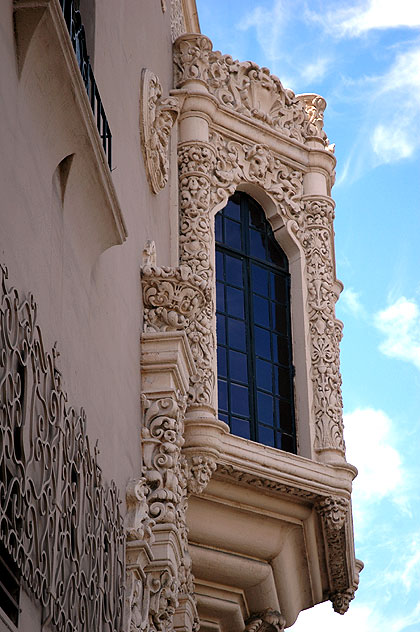 Rococo emerged in France in the early eighteenth century as a continuation of the Baroque business - but not as heavy and dark. The usual words used to describe it are opulence, grace, playfulness, and lightness - carefree stuff, not heroic battles or religious figures. The word Rococo is apparently a combination of the French rocaille, or shell, and the Italian barocco, or Baroque style. You do get a lot of shell-like curves and odd flowers and figures. Anyway, when the term was first used in English, sometime around 1836, it was a colloquialism meaning "old-fashioned." And by the mid-nineteenth century it was - everything had turned all neoclassical.
Rococo emerged in France in the early eighteenth century as a continuation of the Baroque business - but not as heavy and dark. The usual words used to describe it are opulence, grace, playfulness, and lightness - carefree stuff, not heroic battles or religious figures. The word Rococo is apparently a combination of the French rocaille, or shell, and the Italian barocco, or Baroque style. You do get a lot of shell-like curves and odd flowers and figures. Anyway, when the term was first used in English, sometime around 1836, it was a colloquialism meaning "old-fashioned." And by the mid-nineteenth century it was - everything had turned all neoclassical.
Rococo hit Hollywood big-time in the late twenties, when the film industry really took off, at the tail end of the silent film era. And a few of the Rococo palaces are still around.
This is the Avalon Hollywood, 1735 North Vine - just a few steps up from Bob Hope Square (Hollywood and Vine), and sort of across the street from the famous Capitol Records Building. This opened in 1927 as the Hollywood Playhouse, but it was the El Capitan in the forties, then the NBC Radio Theater, then the Hollywood Palace. It was the home of Ken Murray’s "Blackouts" and "Hollywood Palace" - television variety shows from the fifties no one remembers. Some might remember the "Colgate Comedy Hour" and "This is Your Life," and "The Jerry Lewis Show" - and the first years of "The Lawrence Welk Show." Those were done here, as was the first nationally televised telethon. But it wasn't Jerry Lewis getting all weepy with the sick kids - it was to raise funds for the 1952 US Olympic Team. Bob Hope and Bing Crosby and Frank Sinatra were featured.
These days it's a techno-thump dance club, as explained here - "Avalon Hollywood and WiredLA present Avaland - voted one of the top three dance music clubs in the nation and Number One in Los Angeles. Avaland features the world's biggest names in the electronic dance-scene coupled by some of the cities best local talent. Residents include world renowned DJ's Sasha, Danny Howells, Roger Sanchez, Sander Kleinenberg, Hybrid, Ferry Corsten, Nick Warren and more - all presented with Avalon's own EAW Avalon Series Sound System, twenty-six moving lights, an LED wall, and top-of-the line decor."
Things change. It's still Rococo.
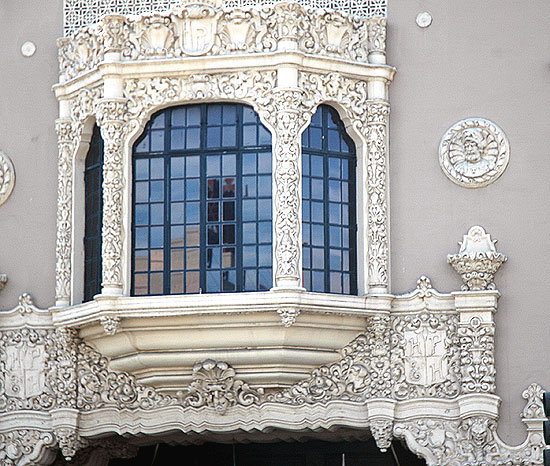
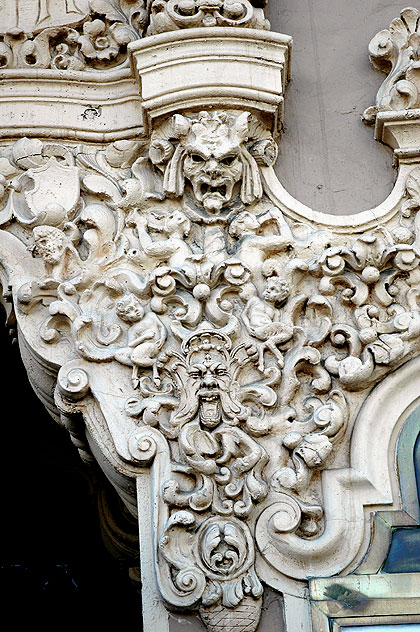
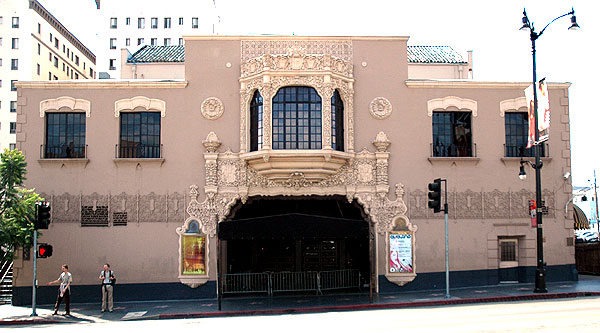
Neighborhood Ghosts - Marlene Dietrich
Topic: Historic Hollywood
Neighborhood Ghosts - Marlene Dietrich
 After living for fifteen years in Hollywood you'd think you'd at least know the neighborhood. But then one day this week, with traffic jammed on the Sunset Strip, three short blocks from home, an angry impulsive right turn at the Chateau Marmont, downhill on Harper to get around it all, led to the North Harper Avenue Historic District - roughly North Harper Avenue between Fountain and De Longpre, in what is now West Hollywood. It's on the National Register of Historic Places and everything. It's a block of fantastic and elaborate apartment buildings from Hollywood's Golden Age - where the likes of Katherine Hepburn, Norma Talmadge and Gilbert Roland once lived, in an odd sort of splendor. The buildings have been carefully restored, and they're still in use. The street, in spite of being one block below the heart of the Sunset Strip, is very quiet. It's like stepping back in time.
After living for fifteen years in Hollywood you'd think you'd at least know the neighborhood. But then one day this week, with traffic jammed on the Sunset Strip, three short blocks from home, an angry impulsive right turn at the Chateau Marmont, downhill on Harper to get around it all, led to the North Harper Avenue Historic District - roughly North Harper Avenue between Fountain and De Longpre, in what is now West Hollywood. It's on the National Register of Historic Places and everything. It's a block of fantastic and elaborate apartment buildings from Hollywood's Golden Age - where the likes of Katherine Hepburn, Norma Talmadge and Gilbert Roland once lived, in an odd sort of splendor. The buildings have been carefully restored, and they're still in use. The street, in spite of being one block below the heart of the Sunset Strip, is very quiet. It's like stepping back in time.
It's an architectural giggle - extreme Art Deco, Spanish Colonial Revival, Monterey Revival, elaborate Italianate monsters - and fountains and statues, hidden gardens and fantastic ironwork and detailing. It's a bit off the beaten path, but rather wonderful. There will be a full photo spread in the upcoming Sunday issue of Just Above Sunset, the magazine-format parent to this website. But here's a taste of it.
Romanesque Villa (1928)
1301-1309 North Harper Avenue In 1928, Michael and Isaac Mann commissioned Leland Bryant to design an apartment building at the corner of Harper and Fountain Avenues. Bryant combined Spanish Colonial Revival and Churrigueresque style was named after the 18th century Spanish architect, Jose Churriquera, who used lavish ornamentation in his designs. It was at this building that the infamous "triangle" between Marlene Dietrich and Josef and Riza Von Sternberg took place and led eventually to the divorce of the Von Sternbergs.
That's amusing. You can imagine her here.
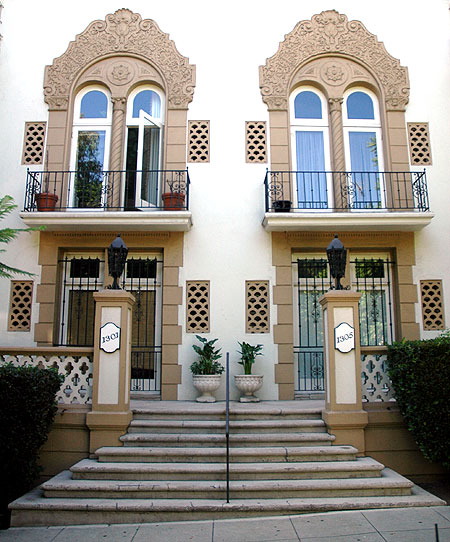
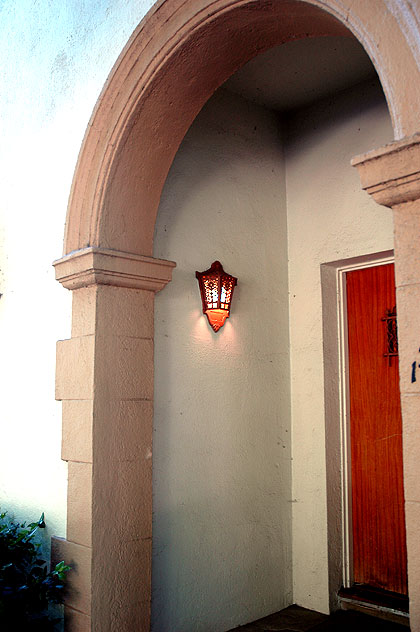

Facts (perhaps) -
Marlene Dietrich (December 27, 1901 - May 6, 1992) was an Academy Award-nominated German-American actress, entertainer and singer. The American Film Institute named Dietrich among the Greatest Female Stars of All Time, ranking here at number nine.
She was born Maria Magdalene Dietrich in Berlin-Schöneberg, Germany to Louis Erich Otto Dietrich and Wilhelmina Elisabeth Josephine Felsing on December 27, 1901. Nicknamed "Lena" within the family, she contracted her two first names to form the then-unusual name, Marlene, when she was still a teenager. Marlene studied the violin before starting work as a chorus girl and actress for Max Reinhardt in theatre productions in Berlin and Vienna throughout the 1920's.
Marlene made her film debut in 1923. In 1929, she got the role of "Lola-Lola" in UFA's production, The Blue Angel (1930), which was one of the first European sound films. The film was directed by Josef von Sternberg.
She then moved to Hollywood to make Morocco, for which she received her only Oscar nomination. Her most lasting contribution to film history was as the star in several films directed by von Sternberg in the pre-Code early 1930s, such as The Scarlet Empress and Shanghai Express, in which she played "femmes fatales" She gradually broadened her repertoire in Destry Rides Again, The Spoilers, A Foreign Affair, Witness for the Prosecution, Touch of Evil and Judgment at Nuremberg.
In 1937, while her film career stalled in Hollywood, she made a film in London for producer Alexander Korda. In later interviews, she claimed that while in London to film Knight Without Armour (1937) she was approached by representatives of the Nazi party to return to Germany, but turned them down flat. Her US film career was revived with the Western Destry Rides Again (1939) costarring James Stewart, and featuring a famous fistfight with the character played by actress Una Merkel. Dietrich became an American citizen in 1939.
Unlike her professional celebrity, which was carefully crafted and maintained, Dietrich's personal life was kept out of public view. She married once, to director's assistant Rudolf Sieber, a Roman Catholic who later became a director at Paramount Pictures in France.
Her only child, Maria Elizabeth Sieber (married name Maria Riva), was born on December 13, 1924. When Maria Riva gave birth to a son in 1948, Dietrich was dubbed "the world's most glamorous grandmother." The great love of the actress's life, however, was the French actor and military hero Jean Gabin. Their relationship ended in the mid-1940's. During the 1950's, she had relationships with Edward R Murrow, Yul Brynner and Frank Sinatra. As for her husband, he had a tragically unstable longterm mistress, Tamara Matul, with whom he lived on a chicken farm in California. Dietrich and her husband remained close.
She was reportedly offered a king's ransom to return to Germany, due to her immense popularity as well as Hitler's ardour, which she declined. It is true that she quipped that she would return only when one of her Jewish friends (possibly Max Reinhardt) could accompany her.
It has also been indicated that she was bisexual, having romantic affairs with actresses like Ona Munson and writer Mercedes de Acosta. Dietrich was also involved with President John F. Kennedy.
No mention of the Josef and Riza Von Sternberg triangle.
Mixed Mode
Topic: Historic Hollywood
That's the Art Deco Sunset Tower Hotel up there on the Sunset Strip (8358 Sunset Boulevard), back to its original name after being the Argyle for a bit - 1929, architect Leland A. Bryant. It's very famous, in a good number of films, and once home to Howard Hughes, John Wayne, Paulette Goddard, Zasu Pitts, and that famous gangster with the great name, Bugsy Siegel. It seems everyone lived there. The link will tell you more. A few other photos of the building are here and here, and in the January 2006 issue of Travel and Leisure there's a feature article here (PDF format) that's says it is one of the best hotels in the world, or may be.
The building may be worth a full photo shoot one day, inside and out, but that's been done by others and getting permission from the PR folks is always a hassle. We'll see. For now, this is how it looked late in the afternoon, September 24, 2006, from Franklin Avenue, with a ratty Faux Norman place in the foreground. The shot sort of captures the late twenties mix of fakery you found out here in those days. The fakery has changed since those days, but not that much - drive through Beverly Hills and look at the new MacMansions. 
Note this screen-grab from the Sunset Tower Hotel site - the man got it right -
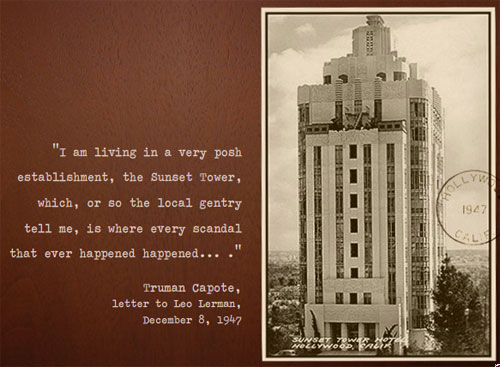
More mixed mode just off Hollywood Boulevard - amusing angles, pigeons and a lamppost -
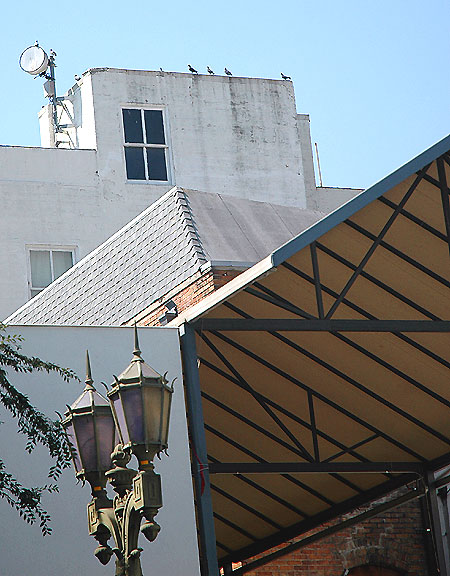
Hollywood Noir
Topic: Historic Hollywood
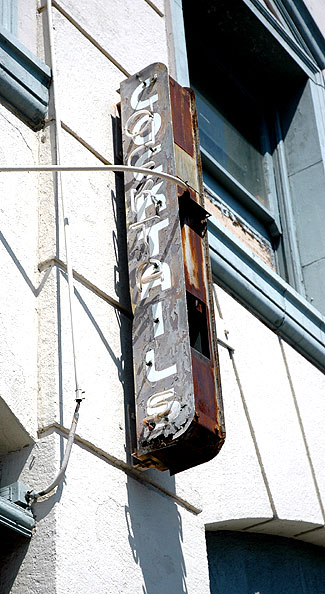 Hollywood - Cahuenga Boulevard, the block south of Raymond Chandler Square - film noir lives on in its surrealistic way. As Chandler said, "It is not a fragrant world."
Hollywood - Cahuenga Boulevard, the block south of Raymond Chandler Square - film noir lives on in its surrealistic way. As Chandler said, "It is not a fragrant world."
See also - "Alcohol is like love. The first kiss is magic, the second is intimate, the third is routine. After that you take the girl's clothes off."
More -
"The pebbled glass door is lettered in flaked black paint: 'Phillip Marlowe … Investigations.' It is a reasonably shabby door at the end of a reasonably shabby corridor in the sort of building that was new about the year the all-tile bathroom became the basis of civilization. The door is locked, but next to it is another door with the same legend which is not locked. Come on in - there's nobody in here but me and a big bluebottle fly. But not if you're from Manhattan, Kansas. - The Little Sister
"It was a blonde. A blonde to make a bishop kick a hole in a stained-glass window." - Farewell, My Lovely (Chapter 13)
"She gave me a smile I could feel in my hip pocket." - Farewell, My Lovely (Chapter 18)
"From thirty feet away she looked like a lot of class. From ten feet away she looked like something made up to be seen from thirty feet away." - The High Window (Chapter 5)
"I'm an occasional drinker, the kind of guy who goes out for a beer and wakes up in Singapore with a full beard." - The King in Yellow
"There was a desert wind blowing that night. It was one of those hot dry Santa Ana's that come down through the mountain passes and curl your hair and make your nerves jump and your skin itch. On nights like that every booze party ends in a fight. Meek little wives feel the edge of the carving knife and study their husbands' necks. Anything can happen. You can even get a full glass of beer at a cocktail lounge." - Red Wind (opening paragraph)
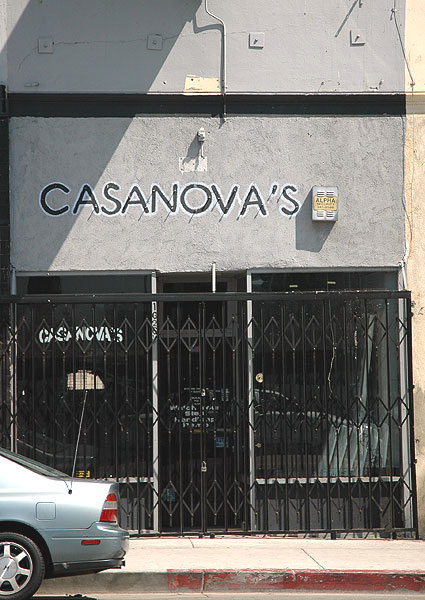

 The mysterious door at 6763 Hollywood Boulevard, a well preserved, two-story Classic Revival building. In the twenties, the Montmartre Café, a popular nightclub, was up on the second floor, and next door was the Embassy Club, a fashionable private club that catered to Hollywood's elite back then. It's all locked up now. Those days are long gone. The star in the sidewalk there, in the Walk of Fame, reads Jascha Heifetz.
The mysterious door at 6763 Hollywood Boulevard, a well preserved, two-story Classic Revival building. In the twenties, the Montmartre Café, a popular nightclub, was up on the second floor, and next door was the Embassy Club, a fashionable private club that catered to Hollywood's elite back then. It's all locked up now. Those days are long gone. The star in the sidewalk there, in the Walk of Fame, reads Jascha Heifetz. 




 Rococo emerged in France in the early eighteenth century as a continuation of the Baroque business - but not as heavy and dark. The usual words used to describe it are opulence, grace, playfulness, and lightness - carefree stuff, not heroic battles or religious figures. The word Rococo is apparently a combination of the French rocaille, or shell, and the Italian barocco, or Baroque style. You do get a lot of shell-like curves and odd flowers and figures. Anyway, when the term was first used in English, sometime around 1836, it was a colloquialism meaning "old-fashioned." And by the mid-nineteenth century it was - everything had turned all neoclassical.
Rococo emerged in France in the early eighteenth century as a continuation of the Baroque business - but not as heavy and dark. The usual words used to describe it are opulence, grace, playfulness, and lightness - carefree stuff, not heroic battles or religious figures. The word Rococo is apparently a combination of the French rocaille, or shell, and the Italian barocco, or Baroque style. You do get a lot of shell-like curves and odd flowers and figures. Anyway, when the term was first used in English, sometime around 1836, it was a colloquialism meaning "old-fashioned." And by the mid-nineteenth century it was - everything had turned all neoclassical. 


 After living for fifteen years in Hollywood you'd think you'd at least know the neighborhood. But then one day this week, with traffic jammed on the Sunset Strip, three short blocks from home, an angry impulsive right turn at the Chateau Marmont, downhill on Harper to get around it all, led to the North Harper Avenue Historic District - roughly North Harper Avenue between Fountain and De Longpre, in what is now West Hollywood. It's on the National Register of Historic Places and everything. It's a block of fantastic and elaborate apartment buildings from Hollywood's Golden Age - where the likes of Katherine Hepburn, Norma Talmadge and Gilbert Roland once lived, in an odd sort of splendor. The buildings have been carefully restored, and they're still in use. The street, in spite of being one block below the heart of the Sunset Strip, is very quiet. It's like stepping back in time.
After living for fifteen years in Hollywood you'd think you'd at least know the neighborhood. But then one day this week, with traffic jammed on the Sunset Strip, three short blocks from home, an angry impulsive right turn at the Chateau Marmont, downhill on Harper to get around it all, led to the North Harper Avenue Historic District - roughly North Harper Avenue between Fountain and De Longpre, in what is now West Hollywood. It's on the National Register of Historic Places and everything. It's a block of fantastic and elaborate apartment buildings from Hollywood's Golden Age - where the likes of Katherine Hepburn, Norma Talmadge and Gilbert Roland once lived, in an odd sort of splendor. The buildings have been carefully restored, and they're still in use. The street, in spite of being one block below the heart of the Sunset Strip, is very quiet. It's like stepping back in time. 





 Hollywood - Cahuenga Boulevard, the block south of
Hollywood - Cahuenga Boulevard, the block south of 
